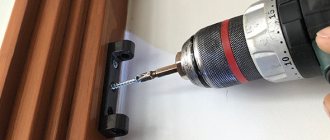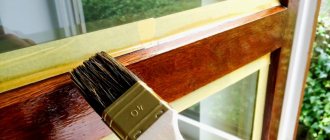Despite the popularity of energy-saving structures made of metal-plastic profiles, there are still many adherents of wooden windows. A number of reasons force one to make a choice in favor of wooden structures: a healthy indoor microclimate, environmentally friendly material, high decorative qualities of the product.
A positive property - the ability of natural material to “breathe”, has another side - increased heat loss indoors. Owners of wooden windows need to take timely care of reliable insulation for the cold season.
RECOMMENDED ON THE TOPIC
- How to choose suitable curtains for windows
- What profile for plastic...
Experts have calculated that an apartment loses 30% more heat through the window perimeter than through the same wall area. Which, by the way, can also be insulated. Read about insulating an apartment from the inside.
Places on windows with poor seals can be detected with a burning candle. On a windy day, we will carry it along the window frame, where the flame will fluctuate, there is a place for heat leakage. Such areas must be insulated from the inside and outside of the room.
You can invite specialists to do the work, but it won’t be difficult to do it yourself with the help of improvised materials and special materials.
No. 1. Where does the insulation of wooden windows begin?
Insulation of old wooden windows begins with examining the structure to detect cold bridges , i.e. the main routes of cold air entering the apartment. It is important to find all the weak points in order to carry out comprehensive insulation . The main cold bridges in wooden windows include:
- the junction of the window frame and sash;
- wood from which the frame is made;
- glass;
- slopes, window sills and ebb.
It is better to insulate the slopes, ebb and window sill from the outside, the remaining elements require insulation from the inside, so you will have to work hard to turn an old wooden window into an airtight one that meets current comfort requirements.
If the window inspection and its insulation are carried out efficiently, you can count on an increase in the temperature in the apartment by 3-40C if you are connected to centralized heating, or on significant cost savings if individual heating is used. In addition, it will be possible to get rid of drafts. The other side of the coin is the cessation of natural air circulation. This problem is also typical for sealed plastic windows. Its solution is periodic ventilation or installation of special valves that allow you to regulate the amount of fresh air entering the apartment.
Be prepared for the fact that for effective insulation you will have to use several of the methods described below. Let's start with the technologies that are used for internal insulation.
What it is?
The seal for this modification of windows is a flexible cord or tape made of rubber, synthetic rubber or silicone , made with different profiles. It is glued to the wooden surface of the frame or inserted into pre-prepared grooves in order to create the tightest possible clamping of the sashes to the frame structure.
What is it needed for?
The need to place rubber products on wooden frames is predetermined by the nature of the wood.
It's no secret that wood, under the influence of the external environment, can change its shape : shrink or swell, becoming saturated with moisture.
These phenomena lead to deformation of frames and the appearance of cracks.
Such violations create many problems:
- there are drafts in the house;
- heat loss and humidity increase, which leads to increased heating costs;
- the room becomes noisy due to street sounds;
- the wooden frame begins to rot, which contributes to its premature failure.
The main functions of the seal on wooden windows:
- insulation of interior spaces from moisture and street noise;
- protection of the wooden frame from atmospheric moisture;
- resistance to the entry of cold and heat from the street into the room;
- ensuring the tightness of the glass unit;
- protection against dust ingress;
- protection against condensation on glass.
No. 2. Insulation of windows with paper
The most ancient, simple and inexpensive way . Today it is rarely used, but it is suitable if the budget is very limited. There are several variations of this insulation method:
- newspapers, wallpaper, paper are torn into pieces, twisted into ropes, which clog the cracks between the sash and the window; to simplify the task, use a ruler, knife, screwdriver or other sharp tools. Some people advise pre-wetting the flagella in water;
- paper waste is shredded, soaked in water and wrung out. To the resulting mass add 1 part clay or 2 parts crushed chalk. The result is a plastic putty that penetrates well even into the smallest cracks.
The classic old-fashioned recipe involves sealing paper insulation with strips of fabric or paper . In order for them to stick well, they were moistened with a solution of laundry soap or a homemade paste was used. The latter can be obtained by mixing water and flour in equal proportions, stirring well and bringing the resulting mixture to a boil.
A more modern option is to use masking tape or special window tape . In this case, the task is simplified, but costs still remain. Windows insulated with paper cannot be opened for ventilation if it suddenly gets warmer in the middle of winter. In the spring you will have to remove the strips of paper/fabric/adhesive tape and take out the insulation. Visible marks remain on the window frames, sometimes even some of the paint is removed, so, unfortunately, you cannot do without updating the decorative coating. However, fabric and self-adhesive paper are the easiest to remove and leave minimal marks.
Selection rules
When choosing insulation, you need to consider the following tips:
for wooden frames it is important to use strictly non-flammable material;- much depends on the average wind speed and average temperature during the operating period - not all of the listed products can serve for a long time in severe frosts;
- you need to take into account the width of the slots in the frame. 5-7 millimeters - you can forget about the tape and pay attention to either a self-adhesive seal or putty;
- The product should only be purchased from a trusted store.
Also, when choosing, you should take into account your financial capabilities and skills - some products are quite expensive and require special steps for processing.
No. 5. Insulation of a wooden window with foam rubber and sealant
A much more modern, reliable and effective method of insulation is the use of foam tape and sealing cords.
Foam tape is inexpensive, but its service life is only about 2 years. This method of insulation is optimal when sufficiently large gaps have formed between the sashes and the frame. The installation process itself is simple, but labor-intensive, since everything needs to be accurately measured and carefully glued so that the window is well insulated, but at the same time does not stop closing normally. The main advantage of this method is the ability to open the window.
The process of insulation with foam tape comes down to the following:
- measuring the required length and width of the tape. The length should correspond to the perimeter of the valves, and the compressed width should correspond to the width of the voids;
- the places on the doors where the tape will be glued must first be cleaned of dust and degreased with alcohol or acetone;
- foam rubber tapes are produced, as a rule, with a self-adhesive base, so the task is simplified and comes down to only removing the protective layer and carefully gluing the foam rubber to the designated places;
- Some experts advise additionally sealing the window with paper tape, but this loses the main advantage of the method - the ability to open the window whenever you want. An alternative solution is to glue foam rubber in several rows.
Insulation made using sealing cords . They are made from different materials:
- rubber;
- polyvinyl chloride;
- polyethylene foam;
- polyurethane.
The main advantage of a rubber seal is its price, but when the temperature drops, it can harden and break. In addition, rubber is highly wear-resistant, so it is best chosen for windows that constantly open and close. Although other types of cords are more expensive, they perform much better in terms of operation.
Sealing cords are made in different shapes - the choice depends on the size of the cracks in the window structure:
- a seal whose profile resembles the letter P is suitable for windows with medium-sized cracks;
- seal with a D-shaped profile - for sealing fairly large gaps;
- seal type E - for windows with small gaps.
Tubular seals allow you to achieve a fairly high level of sealing, do not interfere with the free opening of the window, can be left in the summer and serve for several seasons in a row. The seal may have a self-adhesive base and then its installation will be identical to the installation of foam rubber tapes described above. If you take such a seal, pay attention to the shelf life of the glue: if it comes to an end, the cord may either not stick at all or quickly peel off.
The safest thing to do is to take a separate sealant and separate glue for it, which can be used as silicone sealant. In this case, the durability of the insulation reaches 5 years.
There is one more nuance. All work with tubular profiles is carried out at temperatures above +100C, so it is better not to delay it until cold weather. The seal must be glued very carefully so as not to disrupt the opening system of the sashes.
Average prices in the Russian Federation for installation
In order to correctly install the seal, it will be necessary to disassemble the sashes, which can lead to an imbalance in the operation of the window fittings. Therefore, it is advisable to carry out such work by specialists.
Today there are quite a few companies, both in Moscow and in other regions of Russia, that perform this type of work with high quality and with a guarantee. Prices depend on the glazing area, the number of sashes, the type of seal and the technical condition of the window unit.
Average prices for installation operations by service organizations:
- replacement of rubber seal, 100 rub. m.p.;
- installation of a self-adhesive seal, 50 rubles;
- insulation of wooden windows with rubber seals, 120 RUR per m.p.;
- EPDM installation, 140 rub. m.p.;
- TPE installation, 160 rub. m.p.;
- installation of silicone insulation, 250 rubles. m.p.
No. 6. Insulation of wooden windows using Swedish technology
This is the most progressive, modern and effective way . Windows insulated using Swedish technology are actually equivalent in terms of tightness to modern plastic windows. This method also involves the use of a seal, only for it special grooves are prepared in the window sashes.
Swedish insulation technology involves the following procedure:
- dismantling the sashes;
- cutting thin grooves around the perimeter of the valves, which is carried out with a special cutter; the size of the groove must correspond to the size of the selected seal;
- installation in the grooves of the seal (polyurethane, PVC, polyethylene foam, less often foam rubber is used). No glue is used in this case - the seal holds well due to the thickenings existing in its design;
- applying silicone sealant to the junction of the sash and glass;
- if necessary, fittings and glass are replaced;
- installation of the sashes in place.
The durability of such insulation is 15-20 years , so the labor intensity and high price of the method are fully justified. It’s worth doing such work yourself only if you have at least a little experience in carpentry, otherwise you can only make things worse. The easiest way, of course, is to entrust all the work to specialists.
Windows insulated using Swedish technology can be opened at any time of the year, their appearance does not deteriorate, and sound insulation can be considered an additional bonus.
What not to insulate window frames
The simplest and most well-known options are to cover the windows with film or seal them with adhesive tape for covering windows. These methods will certainly help in maintaining heat, but more and more summer residents are abandoning them. There are several reasons.
Disadvantages of window film:
- Nails need to be driven into the frame every year. Each nail leaves a mark and therefore damages the wooden frame.
- The film completely blocks your view and “cuts off” you from the outside world for the entire winter.
- Even light, transparent tulle hanging on a window reduces the amount of light entering the room. The lack of light from the film will be felt even more strongly, especially if you remember that winter is not the sunniest time of the year anyway.
Disadvantages of adhesive tape for covering windows:
- Every spring you will have to peel off, and in some places even tear off the tape from the frame. The paint will come off along with it (although the manufacturers promise easy and safe peeling off). This means that every spring you will have to repaint all the window frames.
- The cost of adhesive tape is much higher than its paper counterpart. And since this material, unlike film, can only be used once, it’s not exactly a cheap pleasure, especially if there are many windows in the house.
No. 7. Insulating a wooden window with sealant
This method is aimed at thermal insulation of the junction of glass and sash . It can be done with your own hands, but will require a high degree of care and precision. The procedure is as follows :
- removing glazing beads, thin slats that hold the glass around the perimeter. During dismantling, almost all glazing beads break, so it is better to buy new ones in advance, and with a reserve. Removal begins with the lower bead, then the side ones are removed, and only then the top one; for this it is convenient to use a small knife or screwdriver;
- the seat inside the sash is thoroughly cleaned of dirt and dust;
- applying silicone sealant and installing the glass in place. All work on dismantling and installing glass is carried out wearing thick gloves;
- installation of new glazing beads.
Instead of caulk, you can use window putty . The procedure remains the same, only after installing the glass, excess putty must be immediately removed with a knife. In terms of aesthetics, this method is no worse, since subsequently the joint will still be covered with a new bead.
No. 8. Insulating a wooden window with polyurethane foam
Polyurethane foam is used for internal and external insulation ; it fills large cracks well and is used to seal the joints between the frame and the slope, between the slope and the window sill, under the window sill, and between the frame and the top beam.
Working with polyurethane foam is not difficult, but you should know some nuances:
- filling is best done from the bottom up;
- As the foam hardens, it increases in volume, so filling the cracks costs about 1/3;
- work is carried out at air temperatures not lower than +5 and not higher than +300C;
- Polyurethane foam is destroyed under the influence of sunlight, so it must be covered with a layer of finishing material. However, it is unlikely that anyone will leave this material unfinished - it does not look very good.
Instead of polyurethane foam, you can use homemade putty . It is prepared from chalk and gypsum, which are mixed in a 1:2 ratio, and then water is added until a solution of a viscous consistency is obtained. This mixture easily fills all the cracks, and outwardly it looks much more aesthetically pleasing than polyurethane foam.
Which ones are better?
The means for insulating windows from those described above in terms of efficiency and availability are ranked in the top as follows:
| Place | Means | Manufacturer | Price |
| 1. | Self-adhesive seal | Novotex | 260 |
| 2. | Self-adhesive foam | PEAK | 190 |
| 3. | Construction putty | Der Master | 100 |
| 4. | Masking tape | Polyal | 110 |
| 5. | Heat-saving film | LLumar | 500 |
| 6. | Silicone based sealant | Makroflex | 700 |
| 7. | Paraffin | Promexport | 60 |
| 8. | Paper tape/paper/newspaper | Knauf | 50 |
No. 9. Heat-saving film for wooden windows
This method is aimed at increasing the thermal insulation qualities of glass , but today heat-saving film is also glued to a wooden frame. It works like energy-saving double-glazed windows, i.e. allows daylight into the apartment, but does not release heat. This film is made on the basis of polyester, and it receives unique properties to reflect thermal radiation thanks to metal coating. This is a transparent material that does not violate the optical properties of window glass, withstands the effects of detergents, is highly durable and makes the window safe, because if the glass is damaged, all the pieces will remain on the film.
The process of installing the film is simple, but it requires care, because it is important to stick it evenly, without bubbles, with the metallized side facing out. It is best to work with gloves so as not to leave greasy marks on the surface.
Thermal insulation film can make a window “warmer”, but cannot be used as an independent insulation material.
Requirements for materials used for thermal insulation
Exactly what requirements the insulation must meet largely depends on its type. The most important rules are the following :
- sealant, putty and other similar products must maintain their original geometric parameters throughout their entire service life;
- tape, self-adhesive seals must have high adhesiveness and strength;
- cotton wool and foam rubber must meet the recommended values of vapor permeability and moisture absorption.
Also, when choosing a material, you need to take into account the design of the windows:
- for wooden frames, it is primarily important that the product is not flammable;
- another important point for such windows is that the material must be environmentally friendly;
- In the case of plastic windows, the “density” parameter must be taken into account.
Additionally, it is important to take into account the climatic conditions that the selected material will have to withstand. For example, paper tape will not cope with strong winds and frosts.
No. 10. We eliminate gaps in the sashes and frames
It is not enough to seal the gaps between the frame and the sashes, and between the sashes and the glass - the window will still let in cold air if there are cracks in the wooden elements . They certainly appear on wood as a result of temperature changes. It is not difficult to eliminate them; the following materials are used for this:
- paraffin. It is heated in a water bath to a temperature of about 700C, drawn up with a syringe without a needle and filled into all the cracks. Within an hour it will harden and turn into a serious barrier to drafts;
- special wood putty;
- sealant, and you can choose the material to match the color of the wood;
- homemade putty made from plaster and chalk, the recipe for which was described above.
Naturally, such thermal insulation measures will be most effective if you first remove the old decorative coating, then fill the cracks, and after that apply a new layer of finishing. Keep in mind that paint adheres worse to paraffin and sealant, so it is better to carefully remove their excess.
Sealing cracks
It is sometimes necessary to seal the structure, since wood cracks from moisture or sudden changes in temperature.
You can restore the seal and prevent further cracks from occurring in the following way:
- filling the cracks with putty for wooden products;
- sealing the cracks with hot paraffin;
- Fill the hole with sealant of a suitable color.
Painting will help improve and update the appearance of the opening. This will increase the aesthetics of the structure and make the cracks invisible.
No. 11. How to insulate wooden windows from the outside?
Internal insulation is sometimes not enough. Slopes often need additional thermal insulation . Work on their insulation begins with the dismantling of the old finish, after which the surface is primed. The cracks can be filled with polyurethane foam; another option is to cover the slopes with polystyrene foam. After hardening, excess foam is cut off and the surface is treated with plaster. A polymer mesh is attached to the foam on top, perforated tape is placed in the corners, after which plaster is performed. All that remains is to prime and paint the slopes.
The window sill area is also sealed with polyurethane foam. A mandatory requirement is the installation of a special strip for drainage of rainwater. It should be inclined and have rolled edges so that moisture does not get on the walls or through the window. It is advisable to seal the joints between the plank and frame or slope with sealant.
It is better to insulate the area under the window sill with polystyrene foam from the outside, because in a third of cases the most heat flows away through this area.
The final touch of external thermal insulation is updating the paintwork. The old peeling layer of paint can be removed using a spatula and a hair dryer, and fresh paint or varnish can be applied instead.
Preparatory stage
First, you need to assess the situation, that is, find out where the draft is coming from - from the frames or from under the window sill? The reason may be an old seal or defective slopes.
To determine the area from which the cold is blowing, just run your palm over the surface of the window frame. If you cannot identify the cause, you can hold a lighted candle near the window block. The flame of a fire is most sensitive to drafts.
- Possible gaps and cracks can be indicated by moisture after the previous rain, which is concentrated in a certain place. When water accumulates in the corner of a window opening, most likely the reason lies in the joints.
- Drafts can occur due to poor sealing. You can do an experiment. A piece of paper is placed in an open window and the frame is closed. If the sheet is easily pulled out, then the seal is weakly pressed against the window frame.
When choosing a method of insulation, you need to clearly understand the purpose for which this is being done? Sometimes, in pursuit of cheapness, a window loses its attractive appearance and the approach to the window is blocked.
It is important to consider the price of materials. Some of them are quite affordable (the sealant costs no more than 200 rubles per can). More durable methods will cost more, but may be a worthy investment in the future.
No. 12. Insulation of wooden windows in a wooden house
A wooden house places increased demands on the aesthetics of all work carried out. In principle, you can use any insulation technology, but be extremely careful. It is best to use a transparent sealant for thermal insulation of the junction of glass and frame, heat-saving films, fill large cracks with polyurethane foam and then seal them with casing. An excellent way to additionally insulate windows in a wooden house is to install shutters .
cotton wool
Sealing cracks with cotton wool or soft cloth is in many ways similar to the previous insulation method. Using a sharp object, the material is pushed into the frame joints. Adhesive tape or a strip of fabric soaked in soapy water is glued on top.
The disadvantages of insulation with cotton wool are the same as with paper:
- Inability to ventilate a window when the temperature rises temporarily;
- Paint peeling off when removing strips of fabric.
In this case, the cotton wool can be easily removed when “unpacking” the window. It does not turn yellow or harden during the winter. Cotton wool for work can be used both technical and ordinary household.










